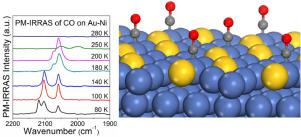Surface Science ( IF 2.1 ) Pub Date : 2021-06-13 , DOI: 10.1016/j.susc.2021.121892 Linsen Zhou , Yifei Yang , Jun Chen , Ruizhi Qiu , Yunxi Yao

|
Au-Ni bimetallic thin films were grown on refractory metal substrates. CO and H2 adsorption on Au-Ni bimetallic surfaces have been studied by a combination of in situ polarization modulation infrared reflection absorption spectroscopy (PM-IRRAS), temperature-programmed desorption (TPD), and density functional theory (DFT) calculations. It is found CO desorption peak shifts from 413 K on pure Ni surfaces to 293 K on the isolated Ni atoms formed by alloying with Au atoms. The sharp decrease of CO desorption temperature on Au-Ni surfaces with increasing Au coverage is caused by the change of the favored CO adsorption sites from bridge/hollow sites on pure Ni surfaces to Ni top sites on Au-Ni bimetallic surfaces. In situ PM-IRRAS shows two CO adsorption bands on Au sites at 2119 cm−1 and 2103 cm−1 on Au-Ni surfaces at 80 K, which are due to CO bound on under-coordinated Au atoms and electron negatively charged Au sites modified with nearby Ni atoms, respectively. Even with the Au-Ni surface temperature at as low as 100 K, CO adsorption induced Ni surface segregation has been observed by in situ PM-IRRAS. Furthermore, DFT calculation results discover the adsorption energy of CO on Ni top sites continues to decrease with increasing Au coverage due to the geometric ensemble effect and the lowered d-band center after Ni alloying with Au. H2 desorption temperature decreases from 363 K on pure Ni thin films to 302 K with increasing Au coverage to 0.6 ML. A new H2 peak appears at around 170 K on the Au-Ni surfaces with Au coverages between 0.6 ML and 0.9 ML. This new H2 TPD peak is assigned to H2 desorption from the totally isolated Ni sites. With Au coverage above 1.5 ML, there is no any H2 desorption detected. The combined surface science studies and DFT calculations provide new insights into the surface structure-activity correlation of Ni-base bimetallic surface alloys.
中文翻译:

金镍双金属表面上的CO 和 H 2吸附:结合实验和 DFT 理论研究
Au-Ni双金属薄膜生长在难熔金属基材上。已经通过原位偏振调制红外反射吸收光谱 (PM-IRRAS)、程序升温脱附 (TPD) 和密度泛函理论 (DFT) 计算的组合研究了 Au-Ni 双金属表面上的CO 和 H 2吸附。发现 CO 解吸峰从纯 Ni 表面的 413 K 移至与 Au 原子形成合金形成的孤立 Ni 原子上的 293 K。随着 Au 覆盖率的增加,Au-Ni 表面上 CO 解吸温度的急剧下降是由于有利的 CO 吸附位点从纯 Ni 表面上的桥/空心位点变为 Au-Ni 双金属表面上的 Ni 顶部位点。原位 PM-IRRAS 在 2119 cm -1处的 Au 位点上显示了两个 CO 吸附带和 2103 cm -1在 80 K 的 Au-Ni 表面上,这是由于 CO 结合在配位不足的 Au 原子上和分别用附近的 Ni 原子修饰的带负电的 Au 位点。即使 Au-Ni 表面温度低至 100 K,原位 PM-IRRAS 也观察到 CO 吸附诱导 Ni 表面偏析。此外,DFT 计算结果发现,由于几何系综效应和Ni 与 Au 合金化后降低的d 带中心,CO 在 Ni 顶部位点的吸附能随着 Au 覆盖率的增加而继续降低。随着金覆盖率增加到 0.6 ML,H 2解吸温度从纯 Ni 薄膜上的 363 K 降低到 302 K。新的 H 2峰出现在 Au-Ni 表面的 170 K 附近,Au 覆盖范围在 0.6 ML 和 0.9 ML 之间。这个新的 H 2 TPD 峰归因于从完全孤立的 Ni 位点的H 2解吸。当 Au 覆盖率超过 1.5 ML 时,没有检测到任何 H 2解吸。结合表面科学研究和 DFT 计算为镍基双金属表面合金的表面结构-活性相关性提供了新的见解。











































 京公网安备 11010802027423号
京公网安备 11010802027423号